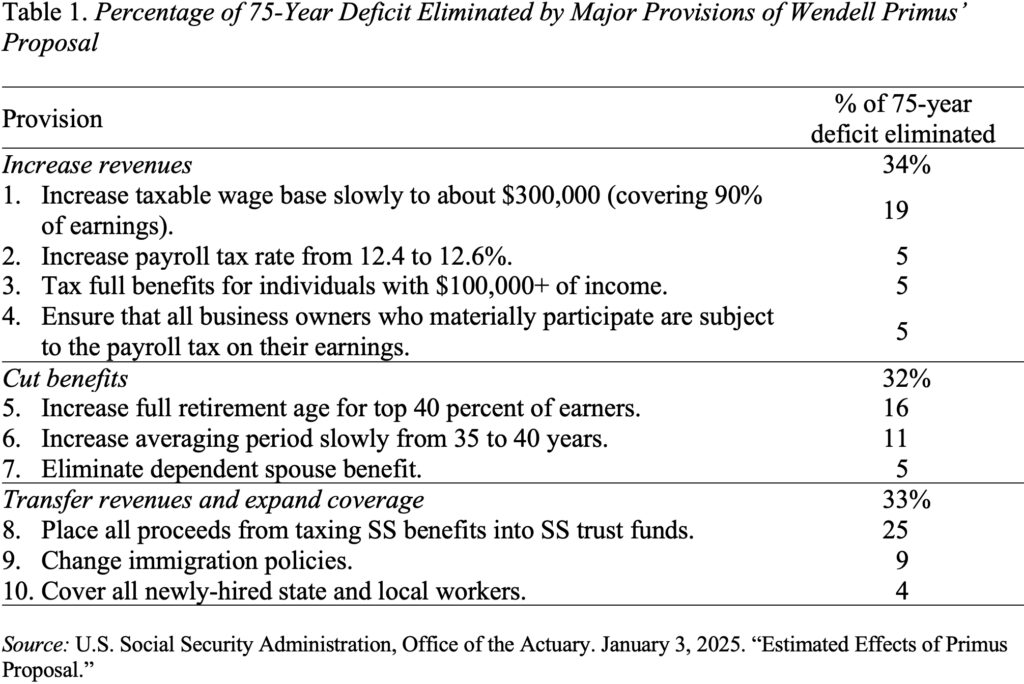
Here’s a Proposal to Fix Social Security that We Could Enact Today
Alicia H. Munnell is a columnist for MarketWatch and senior advisor of the Center for Retirement Research at Boston College.
A mix of tolerable benefit cuts and realistic revenue increases would make everyone better off.
In early January, Social Security’s Chief Actuary released estimates of a comprehensive proposal to restore long-term balance to the program. The request for this estimate was submitted by Rep. Steny Hoyer (D-MD), but the proposal was constructed by Wendell Primus, an economist and long-term Congressional staffer, who spent almost two decades prior to his retirement as the Senior Policy Advisor on Health and Budget issues to Speaker Nancy Pelosi.
The proposal reflects Primus’ extensive knowledge of both policy and politics. It not only eliminates the 75-year deficit but also produces a growing trust fund beyond the 75-year budgeting window. Most importantly, unlike virtually all other proposals submitted to the Chief Actuary for costing, this one includes both revenue increases and benefit cuts, recognizing that any solution will involve some compromise.
The proposal includes 17 provisions – all thoughtful, but let’s focus on the 10 that have a meaningful impact on the 75-year deficit (see Table 1).

- New revenues come from an increase in the taxable wage base from its current level of $168,000 to about $300,000 (as opposed to eliminating the cap altogether), a small increase in the tax rate, greater taxation of benefits for high-income beneficiaries, and ensuring that the pass-through earnings of business owners who materially participate are subject to the payroll tax.
- The major benefit cut is an increase in the full retirement age – but only for those who have seen meaningful increases in life expectancy and can work longer. The two other cuts extend the period for computing average earnings from the highest 35 to highest 40 years and phase out the dependent spouse’s benefit, recognizing the increased labor force participation of women.
- The final component involves the logical move of placing all revenues ever collected from the taxation of retirement and disability benefits into the Social Security trust funds. At this point some of these revenues go to the Hospital Insurance trust fund, so changes would be required in the Medicare program. This component also involves an expansion of coverage by: 1) increasing immigration caps for direct care workers – a group sorely needed to provide long-term care services – and other groups; and 2) extending coverage to the roughly 5 million state and local workers not currently participating in Social Security, who benefit unfairly from Social Security’s progressive benefit formula and family benefits.
There you have it. A comprehensive plan with both benefit cuts and revenue increases that restores Social Security’s finances not only for the next 75 years but also for decades thereafter. It also accomplishes valuable social goals, such as making those who can work longer do so to obtain their “full” benefit amount, expanding coverage to uncovered state and local workers, and improving our legal immigration policies to meet the needs of an aging society.
Let’s just enact this balanced, thoughtful, workable proposal. It would restore confidence in the system both for the young, many of whom believe they will never receive benefits, and for older workers and retirees who fear their benefits will be cut. It would eliminate fearmongering and misinformation. It would make Americans happier.






